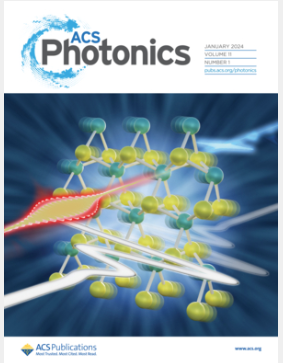zr调制准二维电子气体界面约束实现高响应性柔性β-Ga2O3/IGZO紫外探测器
IF 6.7
1区 物理与天体物理
Q1 MATERIALS SCIENCE, MULTIDISCIPLINARY
引用次数: 0
摘要
准二维电子气体(准2deg)具有独特的量子约束和高电子迁移率,为柔性ga2o3基异质结紫外探测器(UVPDs)带来了变革的希望。然而,柔性极限温度和晶体质量之间的内在矛盾导致了非晶Ga2O3中氧空位(VO)相关的复合,抑制了准2deg的形成,削弱了uvpd的性能。在此,我们设计了一种zr调制的界面工程策略,将具有超低VO浓度的zr掺杂β-Ga2O3 (ZrGaO)薄膜与铟镓氧化锌(IGZO)协同集成,构建柔性异质结uvpd。Zr的掺入有效地钝化了界面缺陷,同时诱导了良好的能带对准,从而成功地促进了界面处准2deg的形成。值得注意的是,量子约束效应导致载流子迁移率显著提高2.1倍,从而协同提高了载流子输运效率和光生电子-空穴分离。最终,该器件在254 nm照明下表现出优异的性能指标:超高的光暗电流比为1.37 × 105,卓越的响应率为1.65 × 102 A W-1,探测率达到1.06 × 1014 Jones,超过了大多数报道的柔性uvpd。此外,柔性器件在1000次不同角度的弯曲循环后仍保持稳定的光电性能,表现出卓越的机械耐久性。这项工作证明了zr调制接口工程在诱导柔性光电子器件的准2deg效应方面的潜力,为下一代高性能可穿戴紫外线检测系统建立了可扩展的设计策略。本文章由计算机程序翻译,如有差异,请以英文原文为准。

High Responsivity Flexible β-Ga2O3/IGZO Ultraviolet Photodetectors Enabled by Zr-Modulated Quasi-Two-Dimensional Electron Gas Interfacial Confinement
Quasi-two-dimensional electron gas (quasi-2DEG), with unique quantum confinement and high electron mobility, holds transformative promise for flexible Ga2O3-based heterojunction ultraviolet photodetectors (UVPDs). However, the intrinsic contradiction between flexible-limit temperature and crystalline quality induces oxygen vacancy (VO) related recombination in amorphous Ga2O3, suppressing quasi-2DEG formation and crippling UVPDs’ performance. Herein, we devise a Zr-modulated interface engineering strategy, where Zr-doped β-Ga2O3 (ZrGaO) films with ultralow VO concentrations are synergistically integrated with indium gallium zinc oxide (IGZO) to construct flexible heterojunction UVPDs. Zr incorporation effectively passivates interfacial defects while inducing favorable band alignment, thereby successfully facilitating the formation of a quasi-2DEG at the interface. Notably, the quantum confinement effect resulted in a significant 2.1-fold increase in carrier mobility, enabling a synergistic improvement in carrier transport efficiency and photogenerated electron–hole separation. Ultimately, the device demonstrates exceptional performance metrics under 254 nm illumination: an ultrahigh photo-to-dark current ratio of 1.37 × 105, remarkable responsivity of 1.65 × 102 A W–1, and detectivity reaching 1.06 × 1014 Jones, surpassing most reported flexible UVPDs. Furthermore, the flexible device retained stable optoelectronic performance after 1,000 bending cycles under varying angles, demonstrating exceptional mechanical durability. This work demonstrates the potential of Zr-modulated interface engineering in inducing quasi-2DEG effects for flexible optoelectronics, establishing a scalable design strategy for next-generation high-performance wearable UV detection systems.
求助全文
通过发布文献求助,成功后即可免费获取论文全文。
去求助
来源期刊

ACS Photonics
NANOSCIENCE & NANOTECHNOLOGY-MATERIALS SCIENCE, MULTIDISCIPLINARY
CiteScore
11.90
自引率
5.70%
发文量
438
审稿时长
2.3 months
期刊介绍:
Published as soon as accepted and summarized in monthly issues, ACS Photonics will publish Research Articles, Letters, Perspectives, and Reviews, to encompass the full scope of published research in this field.
 求助内容:
求助内容: 应助结果提醒方式:
应助结果提醒方式:


